Blue-green
| Blue-green | |
|---|---|
| Hex triplet | #008080 |
| Source | RGB/HTML color model |
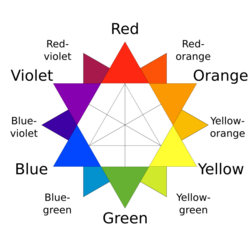
Blue-green is the color between blue and green. It belongs to the cyan family.
Variations
Cyan (aqua)
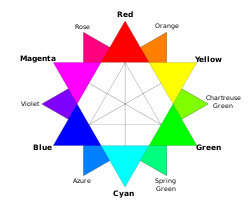
| Cyan (Aqua) | |
|---|---|
| Hex triplet | #00FFFF |
| Source | X11 |
| ISCC–NBS descriptor | Brilliant bluish green |
Cyan, also called aqua, is the blue-green color that is between blue and green on a modern RGB color wheel.
The modern RGB color wheel replaced the traditional old-fashioned RYB color wheel because it is possible to display much brighter and more saturated colors using the primary and secondary colors of the RGB color wheel. In the terminology of color theory, RGB color space has a much larger color gamut than RYB color space.
The first recorded use of cyan as a color name in English was in 1879.[1]
Turquoise
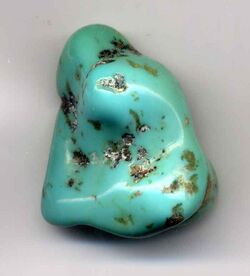
| Turquoise | |
|---|---|
| Hex triplet | #40E0D0 |
| Source | X11 |
| ISCC–NBS descriptor | Brilliant bluish green |
The color turquoise is that of the semi-precious stone turquoise, which is a light tone of blue-green.
Its first recorded use as a color name in English is from 1573.[2]
Green-blue
| Green-blue | |
|---|---|
| Hex triplet | #1164B4 |
| Source | Crayola |
| ISCC–NBS descriptor | Strong blue |
Green-blue is a Crayola crayon color from 1958 to 1990.
Bondi blue
| Bondi blue | |
|---|---|
| Hex triplet | #0095B6 |
| sRGBB (r, g, b) | (0, 149, 182) |
| CMYKH (c, m, y, k) | (100, 18, 0, 29) |
| HSV (h, Saturation (color theory) | (191°, 100%, 71%) |
| Source | Crayola |
| B: Normalized to [0–255] (byte) H: Normalized to [0–100] (hundred) | |
Bondi blue belongs to the cyan family of blues. It is very similar to the Crayola crayon color "blue-green".
Apple, Inc. christened the color of the back of the original iMac computer "Bondi blue" when it was introduced in 1998. It is said to be named for the color of the water at Bondi Beach, in Sydney, Australia.
Blue green (Munsell)
| Blue green (Munsell) | |
|---|---|
| Hex triplet | #00A59C |
| Source | Munsell Color Wheel |
| ISCC–NBS descriptor | Brilliant bluish green |
One definition of the color is in the Munsell color system (Munsell 5BG) although there is wide-spread acceptance and knowledge of the color from the so called blue-green algae which have been recognised and described since the 18th century and probably before that.
Cerulean
blue
|
cerulean
|
teal
|
Cerulean (/səˈruːliən/), also spelled caerulean, is a shade of blue ranging between azure and a darker sky blue. The first recorded use of cerulean as a colour name in English was in 1590.[3] The word is derived from the Latin word caeruleus, "dark blue, blue, or blue-green", which in turn probably derives from caerulum, diminutive of caelum, "heaven, sky".[4]
"Cerulean blue" is the name of a blue-green pigment consisting of cobalt stannate (Co2SnO4). The pigment was first synthesized in the late eighteenth century by Albrecht Höpfner, a Swiss chemist, and it was known as Höpfner blue during the first half of the nineteenth century. Art suppliers began referring to cobalt stannate as cerulean in the second half of the nineteenth century. It was not widely used by artists until the 1870s when it became available in oil paint.[5]| Cerulean | |
|---|---|
| Hex triplet | #007BA7 |
| Source | [3] |
| ISCC–NBS descriptor | Strong greenish blue |
| Cerulean (RGB) | |
|---|---|
| Hex triplet | #003FFF |
| Source | [Unsourced] |
| ISCC–NBS descriptor | Vivid blue |
Teal
| Teal | |
|---|---|
| Hex triplet | #008080 |
| Source | X11 |
| ISCC–NBS descriptor | Moderate bluish green |
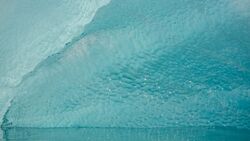
green
|
teal
|
blue
|
alt=American teal duck (male)|thumb|Green-winged teal (male) Teal is a greenish-blue color. Its name comes from that of a bird—the Eurasian teal (Anas crecca)—which presents a similarly colored stripe on its head. The word is often used colloquially to refer to shades of cyan in general.
It can be created by mixing cyan into a green base, or deepened as needed with black or gray.[6] It is also one of the first group of 16 HTML/CSS web colors. In the RGB model used to create colors on computer screens and televisions, teal is created by reducing the brightness of cyan to about one half.
Teal was a fad color during the 1990s, with, among others, many sports teams adopting the color for their uniforms.[7][8]In nature
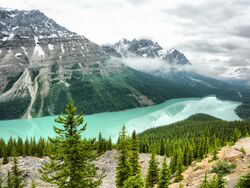
- Blue-green algae are a phylum of bacteria that obtain their energy through photosynthesis.
- The blue green damselfish is a species of damselfish.
- Glacial flour, powdered rock, can turn a lake to a blue-green color.
In culture
- In some languages, blue and green are considered a single color.
- In the iconography of the Virgin of Guadalupe, she is often depicted as wearing a blue-green colored robe. The color is significant to the Mexicas because of the Aztec religion. Also, Blue-green is known as Maya blue in pre-Columbian cultures. In the Nahuatl culture blue represents the center of fire and tonalli. Also sometimes the blue color is diluted so it appears as a turquoise on manuscripts. The color is often used for the representation of Aztec rulers and European kings.[9]
- Variations of blue-green are the political colors (or one of the political colors) of various political parties, including:
- New Right (Denmark )
- DENK (The Netherlands)
- Brexit Party/Reform UK (United Kingdom )
- People-Animals-Nature (Portugal)
- Justice Party (United States )
- In Australia, a loosely-aligned group of independent and minor party candidates that ran in the 2022 Australian federal election were called teal independents for their blend of green and blue (Liberal) politics.
See also
- List of colors
References
- ↑ Maerz and Paul A Dictionary of Color New York:1930 McGraw-Hill Page 194
- ↑ Maerz and Paul A Dictionary of Color New York:1930 McGraw-Hill Page 206; Color Sample of Turquoise [green]: Page 73 Plate 25 Color Sample I5
- ↑ 3.0 3.1 Maerz, Aloys John; Paul, M. Rea (1930). A Dictionary of Color. McGraw-Hill Book Company. p. 190; Colour Sample of Cerulean: Page 89 Plate 33 Colour Sample E6. https://books.google.com/books?id=jnQ0AAAAIAAJ.
- ↑ "cerulean - Search Online Etymology Dictionary". http://www.etymonline.com/index.php?search=cerulean&searchmode=none.
- ↑ Eastlaugh, Nicholas (2004) (in English). The pigment compendium: a dictionary of historical pigments. Amsterdam; Boston: Elsevier Butterworth-Heinemann. pp. 90. ISBN 9780750657495.
- ↑ Cite error: Invalid
<ref>tag; no text was provided for refs namedpainting-decorating-2013-05-22 - ↑ Cite error: Invalid
<ref>tag; no text was provided for refs namedESPN-2016-04-29 - ↑ Cite error: Invalid
<ref>tag; no text was provided for refs namedTheScore-537646 - ↑ Magaloni, Diana (2014). The Colors of the New World: Artists, Materials, and the Creation of the Florentine Codex. Los Angeles: The Getty Research Institute. pp. 43. ISBN 978-1606063293.
 |

